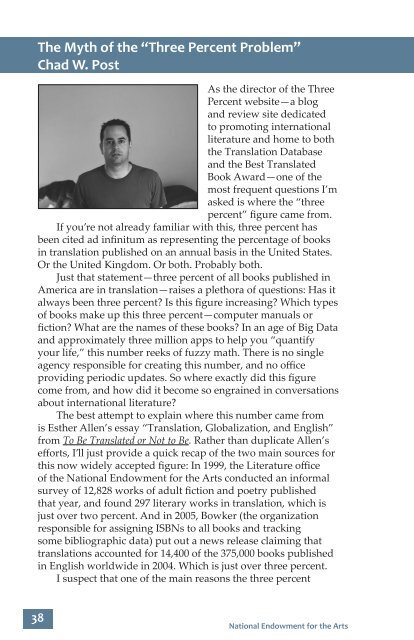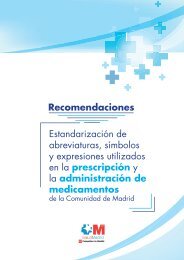lKd7nD
lKd7nD
lKd7nD
You also want an ePaper? Increase the reach of your titles
YUMPU automatically turns print PDFs into web optimized ePapers that Google loves.
The Myth of the “Three Percent Problem”<br />
Chad W. Post<br />
As the director of the Three<br />
Percent website—a blog<br />
and review site dedicated<br />
to promoting international<br />
literature and home to both<br />
the Translation Database<br />
and the Best Translated<br />
Book Award—one of the<br />
most frequent questions I’m<br />
asked is where the “three<br />
percent” figure came from.<br />
If you’re not already familiar with this, three percent has<br />
been cited ad infinitum as representing the percentage of books<br />
in translation published on an annual basis in the United States.<br />
Or the United Kingdom. Or both. Probably both.<br />
Just that statement—three percent of all books published in<br />
America are in translation—raises a plethora of questions: Has it<br />
always been three percent Is this figure increasing Which types<br />
of books make up this three percent—computer manuals or<br />
fiction What are the names of these books In an age of Big Data<br />
and approximately three million apps to help you “quantify<br />
your life,” this number reeks of fuzzy math. There is no single<br />
agency responsible for creating this number, and no office<br />
providing periodic updates. So where exactly did this figure<br />
come from, and how did it become so engrained in conversations<br />
about international literature<br />
The best attempt to explain where this number came from<br />
is Esther Allen’s essay “Translation, Globalization, and English”<br />
from To Be Translated or Not to Be. Rather than duplicate Allen’s<br />
efforts, I’ll just provide a quick recap of the two main sources for<br />
this now widely accepted figure: In 1999, the Literature office<br />
of the National Endowment for the Arts conducted an informal<br />
survey of 12,828 works of adult fiction and poetry published<br />
that year, and found 297 literary works in translation, which is<br />
just over two percent. And in 2005, Bowker (the organization<br />
responsible for assigning ISBNs to all books and tracking<br />
some bibliographic data) put out a news release claiming that<br />
translations accounted for 14,400 of the 375,000 books published<br />
in English worldwide in 2004. Which is just over three percent.<br />
I suspect that one of the main reasons the three percent<br />
38<br />
National Endowment for the Arts



